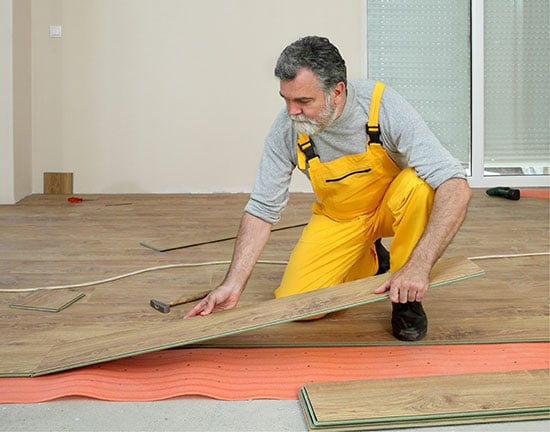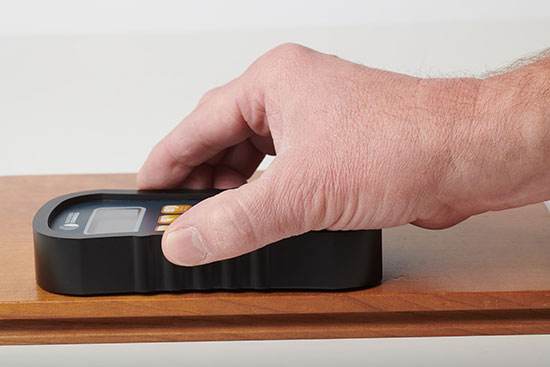How to Avoid a Wood Flooring Disaster in 3 Easy Steps
If you work with wood flooring, you already know that moisture can make or break your flooring project. That’s because wood is hygroscopic, meaning that it readily absorbs or releases moisture in response to ambient conditions.
Why Wood Moisture Content is Important
Wood expands when it absorbs moisture, and it contracts when it releases moisture. You can’t get around this—it is simply what wood does by its very nature.

Before installing wood flooring, always pay close attention to the wood’s moisture content in relation to its surroundings.
Wood flooring problems arise when the wood boards undergo excessive expansion or contraction after installation. This ultimately can lead to disastrous issues, such as cupping, crowning, buckling, and gapping.
Fortunately, you can easily avoid these problems by paying attention to the wood’s moisture content in relation to its surroundings prior to installation. Let’s take a close look at the key steps for how to do this successfully.
Step #1. Take Time to Allow the Wood Flooring to Acclimate
Ideally, you will want to bring the wood flooring to your job site when the interior environment is at service conditions. And once the wood is on-site, it is critically important to allow sufficient time for the flooring to reach a state of moisture balance with its surroundings.
When this moisture balance occurs, the wood is neither absorbing nor releasing moisture and is said to have reached equilibrium moisture content (EMC). The EMC is easy to determine beforehand because it is a calculated number based on the temperature and relative humidity (RH) at the job site, which you then compare with your moisture meter readings.
A common mistake—and one you’ll certainly wish to avoid—is to assume that by bringing the wood to the site a few days ahead of time, you are allowing enough time for the wood to acclimate. Wood doesn’t absorb or lose moisture that fast, which is why step #2 is vital for preventing disaster.
Step #2. Accurately Assess the Wood’s Moisture Content
The only way you can be sure that you have allowed enough time for the flooring to acclimate is to compare the EMC to the moisture content of your wood flooring. The EMC is not a hard-and-fast number. It varies, depending on ambient conditions. Typically, the EMC might be anywhere from about 6% to 11%.
So, how do you check the moisture content in wood? The simplest way is to use a handheld moisture meter calibrated for the type of wood that you are installing. But not just any moisture meter will do, and there are lots of choices.
You’ll want to use a high-quality pinless meter that provides accurate measurements, won’t damage your wood, and can easily be checked for proper calibration. You won’t do yourself any favors if the meter you use is out of calibration or gives readings that aren’t close to the actual moisture level of the wood.
Step #3. Remember to Check the Moisture in the Subfloor
Even if the wood’s moisture content is reasonably close to the EMC, you haven’t yet covered all the bases. It’s important to consider the moisture that may be lurking in the subfloor, too. Whether you are dealing with a concrete or wood-based subfloor, assessing the moisture condition is an absolute must.

For an accurate assessment of wood moisture content, use a high-quality pinless moisture meter.
In the case of a concrete slab, water is one of its most important ingredients. After all, water is what gives concrete its characteristic strength and durability. Just because a concrete floor slab looks perfectly solid and dry on the surface, doesn’t mean that water inside the slab can’t do serious damage to your wood floor.
The most accurate, reliable method for concrete subfloors is to measure moisture at a specific depth via an in-situ RH test. Or, if you are working with plywood or other wood-based subfloors, you can use the same high-quality moisture meter that you’re using for the wood flooring to ensure accurate moisture content readings.
Avoiding a Costly Moisture Disaster
There you have it in a nutshell. Always allow time for your wood flooring to acclimate. And be sure you carefully assess your wood floor product’s moisture content and how it’s likely to respond to the moisture in the air as well as in the subfloor. Anything less and you could be setting yourself up for a costly moisture disaster.
Previously published in Tomorrow’s Contract Floors
Jason has 20+ years’ experience in sales and sales management in a spectrum of industries and has successfully launched a variety of products to the market, including the original Rapid RH® concrete moisture tests. He currently works with Wagner Meters as our Rapid RH® product sales manager.
Related Posts via Taxonomies
Last updated on May 31st, 2022



